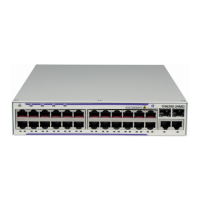Common Configuration Tasks
Page 70 7210 SAS M Services Guide
Configuring an SDP
Note: SDPs are not supported by 7210 SAS-M devices configured in Access Uplink mode.
The most basic SDP must have the following:
• A locally unique SDP identification (ID) number.
• The system IP address of the far-end routers.
• An SDP encapsulation type, MPLS.
SDP Configuration Tasks
This section provides a brief overview of the tasks that must be performed to configure SDPs and
provides the CLI commands.
Consider the following SDP characteristics:
• SDPs can be created as MPLS.
• Each distributed service must have an SDP defined for every remote router to provide
VLL, VPLS, and VPRN services.
• A distributed service must be bound to an SDP. By default, no SDP is associated with a
service. Once an SDP is created, services can be associated to that SDP.
• An SDP is not specific or exclusive to any one service or any type of service. An SDP can
have more than one service bound to it.
• The SDP IP address must be a 7210 SAS-Series system IP address.
• In order to configure an MPLS SDP, LSPs must be configured first and then the LSP-to-
SDP association must be explicitly created.
• In the SDP configuration, automatic ingress and egress labeling (targeted LDP) is enabled
by default. Ingress and egress VC labels are signaled over a TLDP connection between
two 7210 SAS-Series routers.
Note that if signaling is disabled for an SDP, then services using that SDP must configure
ingress and egress vc-labels manually.
To configure a basic SDP, perform the following steps:
1. Specify an originating node.
2. Create an SDP ID.
3. Specify an encapsulation type.
4. Specify a far-end node.

